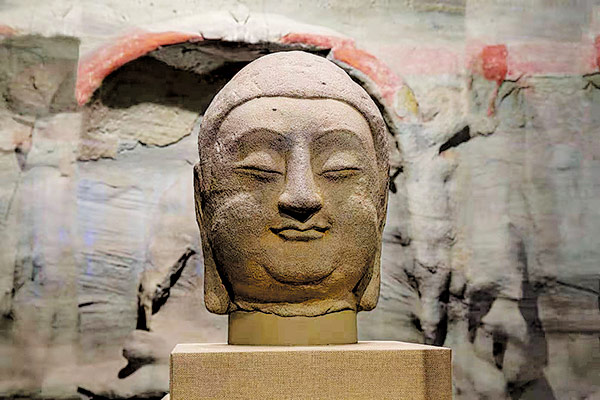

Nearly one century after it was lost, a Buddha head statue repatriated from Japan finally returned to its home in the Tianlongshan Grottoes in Taiyuan, Shanxi province, on Saturday.
The relic, dating to the Sui Dynasty (581-618), was originally set on the northern side in the No 8 Tianlongshan Grottoes, and was believed to be stolen and lost overseas around 1924, according to an appraisal by an expert panel formed by the National Cultural Heritage Administration.
The No 8 Cave was the largest grotto in Tianlongshan, where the carving of caves with Buddhist iconography lasted from the sixth to the early eighth centuries, and is the only one with a specific date of construction (AD 584). This smiling Buddha, with typical artistic features of its time, represents extraordinary craftsmanship and academic values, according to the panel.
The 44.5-centimeter-high Buddha head is the first among stolen items from Tianlongshan to be returned from Japan, according to Li Qun, director of the National Cultural Heritage Administration.
"The fate of cultural relics is linked to the destiny of a country," Li said at the ceremony on Saturday. "Its journey home reflects Chinese people's patriotism, whether they live at home or abroad, and it's a note marking a nation's rejuvenation."
The National Cultural Heritage Administration learned in September that a Buddha head statue was about to be auctioned in Tokyo, and was suspected to be a stolen piece from Tianlongshan. The administration soon began the process of repatriation.
In October, the auction house in Tokyo, whose board chairman Zhang Rong is a Chinese from Hangzhou, Zhejiang province, agreed to cancel the auction.
After negotiations among the administration, Zhang and the local holder of the relic in Japan, the Buddha head was bought by Zhang and donated back. The lost relic was transferred to the Chinese embassy in Tokyo in November. It arrived in Beijing in December.
Zhang was given 300,000 yuan ($46,000) by the Chinese government for his contribution in rescuing the lost relic. But at the return ceremony in Taiyuan, he announced the donation of the entire reward to support the repatriation of more lost Chinese artifacts.
To welcome its return, a special exhibition opened on Saturday in the Tianlongshan Grottoes Museum to review its history through cultural relics, pictures, digitization and 3D-printing technology.
Yu Hao, director of the museum, says the Buddha head will be well protected in the gallery. To avoid damage and natural erosion, the statue will not be put back in the No 8 Cave, because its original position has deteriorated.
Tianlongshan was the most heavily ransacked Chinese Buddhist grotto site by foreign hands in modern times. It was looted in the 1920s, shortly after it was known to foreign explorers, and almost none of the caves remained untouched.
According to Li Yuqun, an archaeology professor with the Chinese Academy of Social Sciences, 233 cultural relics, including 176 Buddha statues, were stolen and lost overseas through a Japanese antique dealing agency. Most of them are in museums or private collections in Japan, Europe and North America.
To mark the return, scholars and administrators of major Chinese grotto temples also held a symposium in Taiyuan. A document titled Tianlongshan Initiative was released, calling for the return of more lost relics of the grottoes from overseas.
Many Chinese Buddhist grottoes other than Tianlongshan were looted by foreign antique dealers from the late 19th century to 1930s.
"China should accelerate the process of researching its grotto relics lost overseas and their ownership," says Huo Zhengxin, a professor at China University of Political Science and Law.
"We need to explore various channels to seek their return and contribute to creating an international consensus to bring lost relics back to the origin countries."